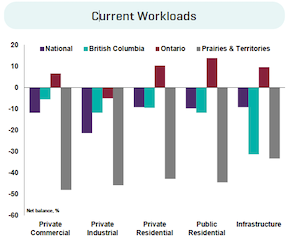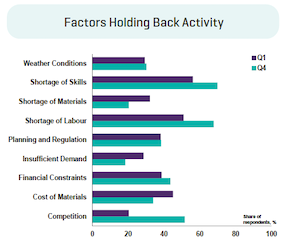Optimism diminishing among contractors: CIQS survey reports
While contractors started to feel the effects of the COVID-19 pandemic on their workloads in the first quarter of 2020, they are increasingly pessimistic about the prospects for industry recovery later in the year.
 The first-quarter 2020 edition of the Canadian Institute of Quantity Surveyors (CIQS) Canada Construction and Infrastructure Survey highlights a number of concerns among the more than 1,300 companies surveyed. Among these are a decrease in optimism for the strength of the construction market, shortages in labour supplies, financial constraints and declining profit margins.
The first-quarter 2020 edition of the Canadian Institute of Quantity Surveyors (CIQS) Canada Construction and Infrastructure Survey highlights a number of concerns among the more than 1,300 companies surveyed. Among these are a decrease in optimism for the strength of the construction market, shortages in labour supplies, financial constraints and declining profit margins.
The survey is a quarterly guide to the trends in the construction and infrastructure markets.
“The suspicion that the legacy of the pandemic will cast a shadow over the construction and infrastructure sectors for some time to come is evident in the forward-looking metrics contained in the survey,” says the report. “Workloads are anticipated to remain subdued over the next twelve months, with employment projected to drop and, most notably, profit margins viewed as coming under pressure.”
With a few exceptions, building demand in the five sectors—private commercial, private industrial, private residential, public residential and infrastructure—has dropped across the country. Some regions are feeling these effects more profoundly than others.
Drops in each of the five market segments in the Prairies and Territories region, for example, are being felt by between 30 percent and 50 percent of regional respondents. National rates vary between 10 percent and 20 percent. Ontario meanwhile has bucked some trends, with only private industrial workloads contracting. A net positive number of respondents see increases in the other work sectors.
One of the major conclusions coming out of the report is a shortage of labourers and skilled workers. The report says that while this issue is always a concern for respondents, the proportion of respondents concerned about these issues has diminished since the end of last year. Nonetheless, about half of respondents list the shortage of skilled workers to be a problem while nearly 40 percent said labour shortages will be problematic.
Other new concerns emerging in the report include material shortages and financial constraints.
 Respondents in Ontario tended to be generally more optimistic than those in the rest of the country. While each of the five market segments in the province reported declines compared with the fourth quarter of last year, the only segment to record overall negative workloads was private industrial.
Respondents in Ontario tended to be generally more optimistic than those in the rest of the country. While each of the five market segments in the province reported declines compared with the fourth quarter of last year, the only segment to record overall negative workloads was private industrial.
The overall “holding pattern” sentiment, says the report is also reflected in the pipeline of work to come.
“Contributors reported little change in new business enquiries, new workloads and headcount. However, repair and maintenance workloads declined while delays in payment increase, perhaps serving as warning signs for the industry,” said the report.
Among the biggest concerns for Ontario contractors were material costs and payment delays, while factors holding back activity in Ontario’s construction sector included shortages of skilled workers and labourers, material costs, financial constraints and insufficient project demand.
The full survey report is available on the CIQS website.








